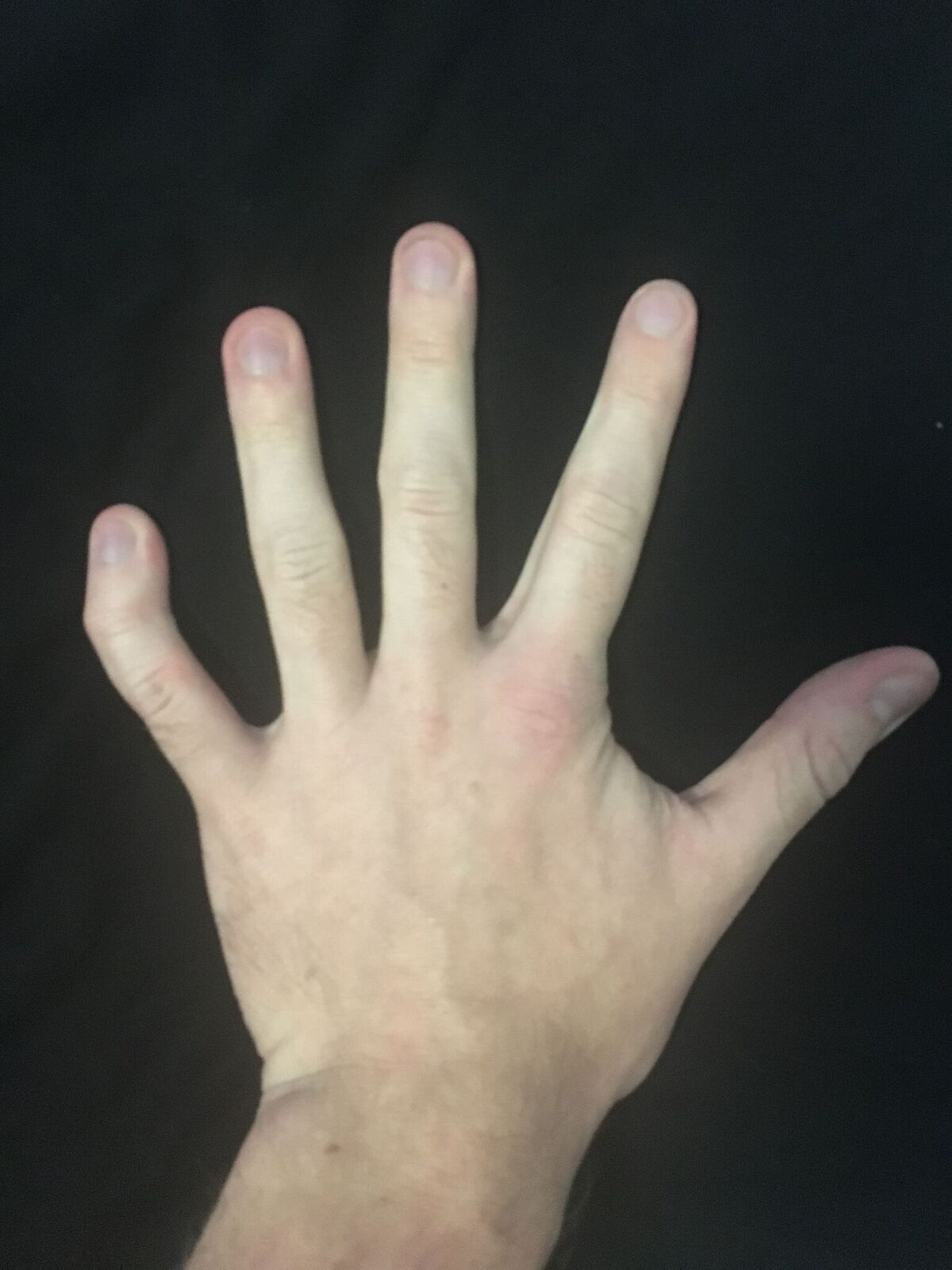Clinodactyly
Editor-In-Chief: Prab R Tumpati, MD
Obesity, Sleep & Internal medicine
Founder, WikiMD Wellnesspedia &
W8MD medical weight loss NYC and sleep center NYC
| Clinodactyly | |
|---|---|

| |
| Synonyms | Brachymesophalangia |
| Pronounce | N/A |
| Specialty | N/A |
| Symptoms | Curved finger, usually the fifth finger |
| Complications | Functional impairment |
| Onset | Congenital |
| Duration | Lifelong |
| Types | N/A |
| Causes | Genetic |
| Risks | Genetic syndromes such as Down syndrome, Klinefelter syndrome |
| Diagnosis | Physical examination, X-ray |
| Differential diagnosis | Camptodactyly, Polydactyly |
| Prevention | N/A |
| Treatment | Surgery if severe |
| Medication | N/A |
| Prognosis | Generally good |
| Frequency | Common |
| Deaths | N/A |
Clinodactyly is a congenital condition characterized by the abnormal curvature of one or more fingers or toes. The term derives from the Greek words klinein, meaning "to bend," and daktylos, meaning "finger." Although clinodactyly can occur in any of the fingers or toes, it most commonly affects the little fingers and is often diagnosed in early childhood. This condition can vary in severity, from a slight bend that does not affect function to a significant curvature that may impair the use of the affected digit.
Clinodactyly is considered a relatively common congenital malformation, presenting as a deviation or bending of a digit towards the radial or ulnar side of the hand or foot. It may occur as an isolated condition or as part of a syndrome involving other anomalies.
Causes
Clinodactyly is often hereditary, passed down from parents to their children through genes. It can also be associated with various genetic conditions, such as Down syndrome, Turner syndrome, and Klinefelter syndrome. The condition results from abnormal development of the bones in the finger or toe, specifically the middle bone, known as the phalanx.
Symptoms
The primary symptom of clinodactyly is the visible curvature of the affected digit. The degree of curvature can vary, and in some cases, it may lead to functional limitations or difficulty with certain activities that require fine motor skills.
Diagnosis
Diagnosis of clinodactyly typically involves a physical examination and, if necessary, imaging tests such as X-rays to assess the severity of the curvature and to plan for potential treatment. Genetic testing may also be recommended if the condition is suspected to be part of a syndrome.
Treatment
Treatment for clinodactyly depends on the severity of the condition and whether it is causing functional impairment. Mild cases may not require treatment. For more severe cases, options may include physical therapy, splinting, or surgery to straighten the affected digit.
Significance
Understanding clinodactyly is crucial for early diagnosis and intervention, especially when associated with broader syndromic conditions. Early treatment can improve function in the affected digit and reduce the likelihood of complications later in life.
See Also
External Links
References
- "Clinodactyly: Causes, Symptoms, and Treatment." Pediatrics.
- "Management of Clinodactyly and Associated Anomalies." Journal of Hand Surgery.
| This article is a medical stub. You can help WikiMD by expanding it! | |
|---|---|
| Congenital malformations and deformations of musculoskeletal system / musculoskeletal abnormality | ||||||||||||||||||||
|---|---|---|---|---|---|---|---|---|---|---|---|---|---|---|---|---|---|---|---|---|
|
Transform your life with W8MD's budget GLP-1 injections from $125.
W8MD offers a medical weight loss program to lose weight in Philadelphia. Our physician-supervised medical weight loss provides:
- Most insurances accepted or discounted self-pay rates. We will obtain insurance prior authorizations if needed.
- Generic GLP1 weight loss injections from $125 for the starting dose.
- Also offer prescription weight loss medications including Phentermine, Qsymia, Diethylpropion, Contrave etc.
NYC weight loss doctor appointments
Start your NYC weight loss journey today at our NYC medical weight loss and Philadelphia medical weight loss clinics.
- Call 718-946-5500 to lose weight in NYC or for medical weight loss in Philadelphia 215-676-2334.
- Tags:NYC medical weight loss, Philadelphia lose weight Zepbound NYC, Budget GLP1 weight loss injections, Wegovy Philadelphia, Wegovy NYC, Philadelphia medical weight loss, Brookly weight loss and Wegovy NYC
|
WikiMD's Wellness Encyclopedia |
| Let Food Be Thy Medicine Medicine Thy Food - Hippocrates |
Medical Disclaimer: WikiMD is not a substitute for professional medical advice. The information on WikiMD is provided as an information resource only, may be incorrect, outdated or misleading, and is not to be used or relied on for any diagnostic or treatment purposes. Please consult your health care provider before making any healthcare decisions or for guidance about a specific medical condition. WikiMD expressly disclaims responsibility, and shall have no liability, for any damages, loss, injury, or liability whatsoever suffered as a result of your reliance on the information contained in this site. By visiting this site you agree to the foregoing terms and conditions, which may from time to time be changed or supplemented by WikiMD. If you do not agree to the foregoing terms and conditions, you should not enter or use this site. See full disclaimer.
Credits:Most images are courtesy of Wikimedia commons, and templates, categories Wikipedia, licensed under CC BY SA or similar.
Contributors: Kondreddy Naveen, Prab R. Tumpati, MD



